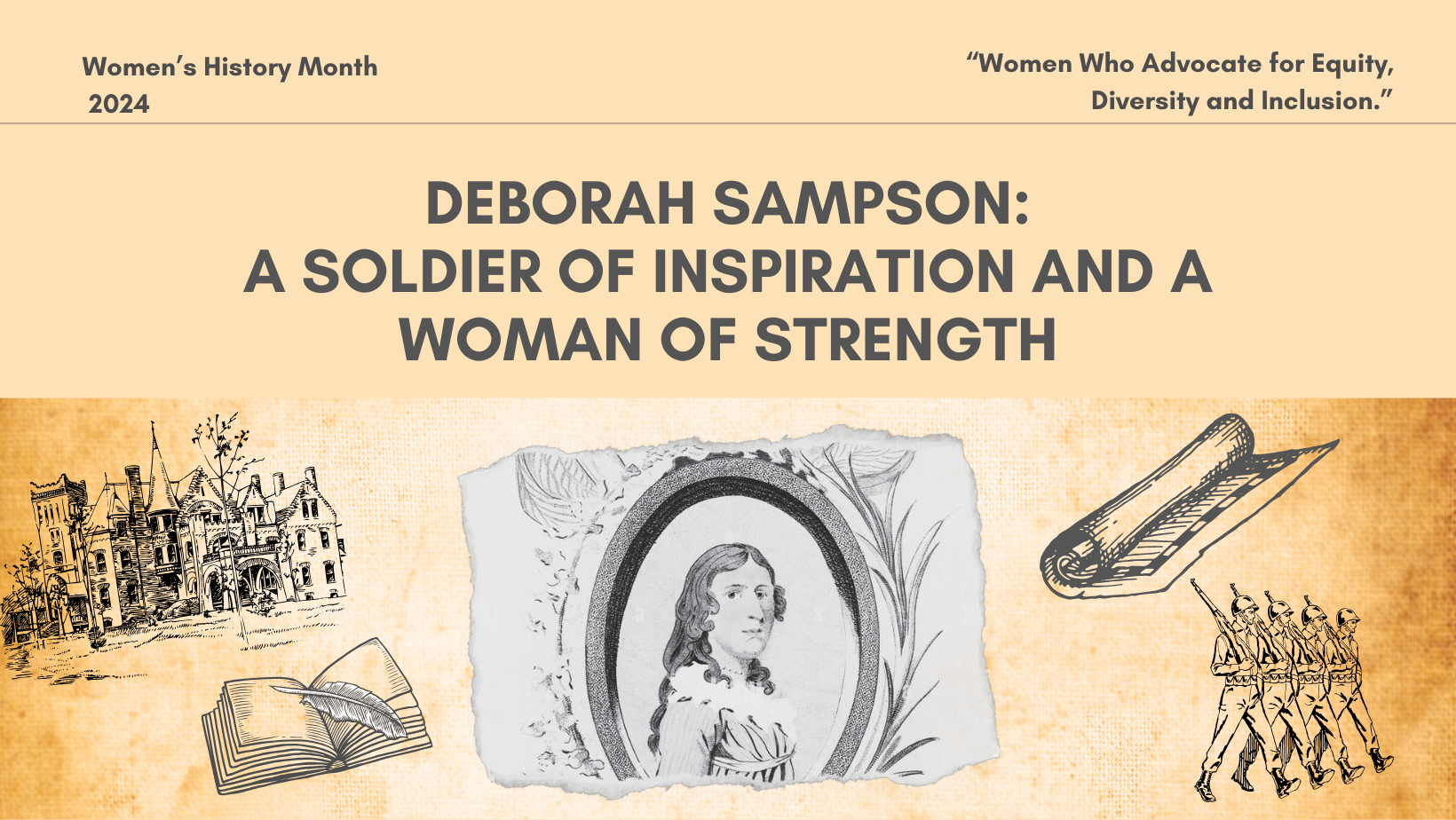- Home
- About Us
- Housing
- Resources
- Contact Us
-
-
-
Address: 223 S. Winnebago Street Rockford, IL 61102
Phone: 815-489-8500
-
-
- Updates
-

Address: 223 S. Winnebago Street Rockford, IL 61102
Phone: 815-489-8500
Address: 223 S. Winnebago Street Rockford, IL 61102
Phone: 815-489-8500


In celebration of Women’s History Month in 2024, the Rockford Housing Authority is honored to showcase Deborah Sampson for her bravery and advocacy for women’s rights.
 Deborah Sampson became a hero of the American Revolution by disguising herself as a man to join the Patriot forces. She is the only woman to have received a full military pension for her service in the Revolutionary army.
Deborah Sampson became a hero of the American Revolution by disguising herself as a man to join the Patriot forces. She is the only woman to have received a full military pension for her service in the Revolutionary army.
Born in Plympton, Massachusetts near Plymouth on December 17, 1760, Sampson was one of seven children born to Jonathan Sampson Jr. and Deborah (Bradford) Sampson. Both had notable ancestry, with Jonathan being a descendant of Myles Standish and Priscilla Alden, and Deborah being the great-granddaughter of Massachusetts Governor William Bradford. Despite their prestigious lineage, the Sampson family faced financial challenges. Following Jonathan’s disappearance during a sea voyage, Deborah, now disadvantaged, had to separate her children and place them in different homes. At the age of 10, Deborah became an indentured servant to Deacon Benjamin Thomas, a farmer in Middleborough with a large family. After completing her indenture at 18, the self-educated Sampson worked as a teacher during summer sessions in 1779 and 1780, and as a weaver during the winter months.
During the Revolutionary War in 1782, the patriotic Sampson, disguised as Robert Shurtleff, joined the Fourth Massachusetts Regiment. Serving in Captain George Webb’s Company of Light Infantry at West Point, New York, she undertook dangerous missions scouting neutral territory to assess British troop and equipment buildup in Manhattan. In June 1782, Sampson, accompanied by two sergeants, led about 30 infantrymen on an expedition that involved multiple encounters with Tories, including some one-on-one battles. Notably, she orchestrated a successful raid on a Tory residence, resulting in the capture of 15 men. Sampson, like many other veterans of the Revolutionary War, claimed to have taken part in the siege of Yorktown, participating in activities such as trench digging, aiding in the capture of a British redoubt, and enduring cannon fire.
For more than two years, Sampson’s real identity remained hidden, evading  discovery despite near misses. When she sustained a cut on her forehead from a sword and was shot in her left thigh, she extracted the pistol ball herself. She was ultimately discovered—a year and a half into her service—in Philadelphia, when she came down with a fever, she was taken to a hospital, and lost consciousness.
discovery despite near misses. When she sustained a cut on her forehead from a sword and was shot in her left thigh, she extracted the pistol ball herself. She was ultimately discovered—a year and a half into her service—in Philadelphia, when she came down with a fever, she was taken to a hospital, and lost consciousness.
After being honorably discharged on October 23, 1783, Sampson returned to Massachusetts. She married Benjamin Gannet from Sharon on April 7, 1785, with whom she had three children: Earl, Mary, and Patience. Herman Mann penned her life story in 1797, titled The Female Review: or, Memoirs of an American Young Lady. She received a military pension from Massachusetts, and following her time in the army, Sampson led a typical life as a farmer’s wife. However, in 1802, she embarked on a year-long lecture tour sharing her experiences, becoming the first woman in America to do so, and occasionally threw on full military attire.
In recognition of his late wife’s extraordinary courage and dedication, Congress decided to award compensation to Sampson’s husband was a moving moment that honored her legacy. This act of acknowledgment symbolized the profound impact that Deborah Sampson had made during the American Revolution, exceeding traditional boundaries and inspiring future generations with her remarkable story of bravery and sacrifice.
Although Sampson and her husband were not united in marriage during her military service, the committee’s ruling highlighted the exceptional nature of her contributions to the Revolutionary cause. By emphasizing her heroism, loyalty, and bravery above all else, they celebrated her as a trailblazer and a role model for women in history. The payment granted to her husband, although afterward, served as a tangible token of gratitude for Sampson’s unwavering commitment to the ideals of freedom and equality.
Despite the bittersweet conclusion of this chapter in Sampson’s story, her legacy endures as a testament to the resilience and courage of individuals who defy conventions and stand up for what they believe in. Through her remarkable deeds and the recognition bestowed upon her by Congress, Deborah Sampson’s memory continues to inspire and uplift those who seek to make a difference in the world, leaving an indelible mark on the tapestry of American history.
RHA is inspired by the remarkable bravery and unwavering advocacy of Deborah Sampson. Her courageous decision to fight for her country, while also championing women’s rights, exemplifies the kind of selflessness and dedication that we strive to embody in our mission.
Deborah Sampson’s ultimate sacrifice serves as a poignant reminder and resembles the 2024 theme of Women’s History Month, by showing the importance of fighting for what one believes in, even in the face of adversity. Her legacy continues to inspire us to create safe and nurturing environments where individuals can pursue their desires and achieve self-sufficiency, responsibility, and empowerment. Just as Deborah Sampson blazed a trail for women’s rights, RHA remains committed to the same mission; fighting for what is right, and providing inclusive, affordable, and initiatives that empower individuals to enhance their quality of life.

To continue to create strategic partnerships with community stakeholders, design a diverse housing portfolio, leverage social service programming to unite and ensure residents are provided with safe and nurturing environments that lead to self-sufficiency, responsibility, and individual empowerment.
This Earth Day, let's unite for a brighter future!
Today, we're reminded of the importance of our planet and the role each of us plays in protecting it.
View the RHA Earth Day 2024 Blog here:
https://rockfordha.org/earth-day-2024/
Effective today, Monday, April 22, 2024, the current RHA Low-Income Public Housing (LIPH) Family Waiting List will open until further notice. Pre-applications can be completed online at https://www.rockfordhousingauthority.com/ and are available at 223 S. Winnebago Street Rockford, IL 61102.
#RHA
Let's come together to celebrate Diversity Month by acknowledging the beauty found in our distinct backgrounds, viewpoints, and identities. #RHA #MovingForwardTogether

Within 5 years the RHA will re-establish itself as high performing agency that is a leader in housing and sustainable communities by developing additional, non-HUD revenue streams, increasing our asset base and offering state of the art resident initiatives.